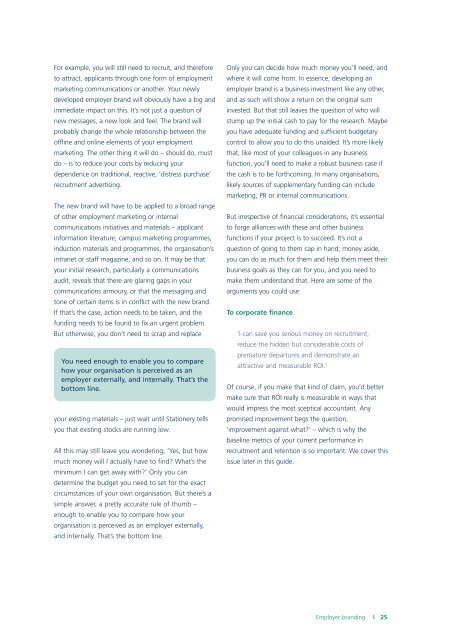Employer branding A no-nonsense approach - CIPD
Employer branding A no-nonsense approach - CIPD
Employer branding A no-nonsense approach - CIPD
You also want an ePaper? Increase the reach of your titles
YUMPU automatically turns print PDFs into web optimized ePapers that Google loves.
For example, you will still need to recruit, and therefore<br />
to attract, applicants through one form of employment<br />
marketing communications or a<strong>no</strong>ther. Your newly<br />
developed employer brand will obviously have a big and<br />
immediate impact on this. It’s <strong>no</strong>t just a question of<br />
new messages, a new look and feel. The brand will<br />
probably change the whole relationship between the<br />
offline and online elements of your employment<br />
marketing. The other thing it will do – should do, must<br />
do – is to reduce your costs by reducing your<br />
dependence on traditional, reactive, ‘distress purchase’<br />
recruitment advertising.<br />
The new brand will have to be applied to a broad range<br />
of other employment marketing or internal<br />
communications initiatives and materials – applicant<br />
information literature, campus marketing programmes,<br />
induction materials and programmes, the organisation’s<br />
intranet or staff magazine, and so on. It may be that<br />
your initial research, particularly a communications<br />
audit, reveals that there are glaring gaps in your<br />
communications armoury, or that the messaging and<br />
tone of certain items is in conflict with the new brand.<br />
If that’s the case, action needs to be taken, and the<br />
funding needs to be found to fix an urgent problem.<br />
But otherwise, you don’t need to scrap and replace<br />
You need e<strong>no</strong>ugh to enable you to compare<br />
how your organisation is perceived as an<br />
employer externally, and internally. That’s the<br />
bottom line.<br />
your existing materials – just wait until Stationery tells<br />
you that existing stocks are running low.<br />
All this may still leave you wondering, ‘Yes, but how<br />
much money will I actually have to find? What’s the<br />
minimum I can get away with?’ Only you can<br />
determine the budget you need to set for the exact<br />
circumstances of your own organisation. But there’s a<br />
simple answer, a pretty accurate rule of thumb –<br />
e<strong>no</strong>ugh to enable you to compare how your<br />
organisation is perceived as an employer externally,<br />
and internally. That’s the bottom line.<br />
Only you can decide how much money you’ll need, and<br />
where it will come from. In essence, developing an<br />
employer brand is a business investment like any other,<br />
and as such will show a return on the original sum<br />
invested. But that still leaves the question of who will<br />
stump up the initial cash to pay for the research. Maybe<br />
you have adequate funding and sufficient budgetary<br />
control to allow you to do this unaided. It’s more likely<br />
that, like most of your colleagues in any business<br />
function, you’ll need to make a robust business case if<br />
the cash is to be forthcoming. In many organisations,<br />
likely sources of supplementary funding can include<br />
marketing, PR or internal communications.<br />
But irrespective of financial considerations, it’s essential<br />
to forge alliances with these and other business<br />
functions if your project is to succeed. It’s <strong>no</strong>t a<br />
question of going to them cap in hand; money aside,<br />
you can do as much for them and help them meet their<br />
business goals as they can for you, and you need to<br />
make them understand that. Here are some of the<br />
arguments you could use:<br />
To corporate finance<br />
‘I can save you serious money on recruitment,<br />
reduce the hidden but considerable costs of<br />
premature departures and demonstrate an<br />
attractive and measurable ROI.’<br />
Of course, if you make that kind of claim, you’d better<br />
make sure that ROI really is measurable in ways that<br />
would impress the most sceptical accountant. Any<br />
promised improvement begs the question,<br />
‘improvement against what?’ – which is why the<br />
baseline metrics of your current performance in<br />
recruitment and retention is so important. We cover this<br />
issue later in this guide.<br />
<strong>Employer</strong> <strong>branding</strong>

















